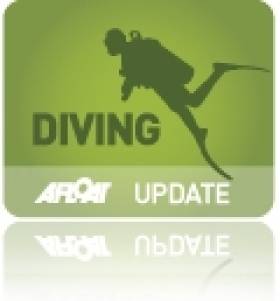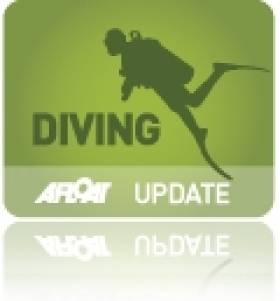Displaying items by tag: Dive
SCUBAPRO Aladin Square Dive Watch At A Discount
Looking for a SCUBAPRO Aladin square Dive wrist watch? One's just been added to Afloat's marketplace at a discounted price. Seller Jeremy Leighton is offering a brand new, unused watch that's still in original packaging. He says this Aladin 2 dive watch normally retails for €425 but is yours for €250. Check it out here.
SCUBAPRO say the Aladin Square Dive Computer gives divers the latest in decompression technology in a clean, easy-to-navigate format. Its large screen and sharp numeric readout are highly visible and will appeal to divers who want to focus more on their surroundings than their gear.
Anyone can add items to the marketplace. Click for more info here
Galway Student Sub-Aqua Club Celebrates 50 Years Underwater!
#sub-aqua – In the year of its 50th anniversary, the NUIG/GMIT Sub-Aqua Club officially launched its new Rigid Inflatable Boat (RIB), Alice Perry, at a special ceremony in NUI Galway recently. Launched by NUI Galway's Vice-President for the Student Experience, Dr Pat Morgan, the RIB was blessed by the University's Chaplain, Fr Diarmuid Hogan.
In 2009 work began on raising funds to purchase a new offshore class RIB for the Club to allow greater access to some of the fantastic offshore dive sites that lie around Ireland. In late 2011, the NUI Galway Students Project Fund granted the remaining funds required.
The new 6.5m XS-650 RIB is named after NUI Galway graduate Alice Perry, who graduated with a first class honours degree in Civil Engineering in 1906. Alice was the first female to graduate with an engineering degree in Ireland or the UK. She went on to hold the position of County Surveyor for Galway, where her work included the inspection of Galway's piers, before later moving to London and eventually Boston.
Speaking at the launch, Martin Timoney of the NUIG/GMIT Sub-Aqua Club said: "I thank all those who helped in procuring the Clubs new RIB; from attaining the required funds, through the NUI Galway Students Project Fund, to the deriving the final specification for the RIB to is final delivery in late June. It has taken a lot of time and effort but the new RIB, Alice Perry will allow access to some fantastic dive sites for the club."
Annual events for the NUIG/GMIT Sub-Aqua Club include a Charity Fundraiser Dive with all the proceeds donated to local charities and groups involved in water safety where divers from the Club cumulatively spend 30 hours in the 3.5m deep tank in one hour time slots. This year over €1,600 was raised for the Galway RNLI Station and the Search and Recovery Unit of the Galway Sub Aqua Club. The Club also provides safety boat cover at a number of events, including Tri the Burren Triathlon and the Cope Triathlon, and this year the Volvo Ocean Race finale. Working with Galway Sub-Aqua Club, the Club provided safety boat cover in Galway Bay for each of the inshore practice and race days, as well as within the docks in the evenings.
The Club dives locally on a regular basis to such sites as Coral Beach, Bóthar Buí and Killary Fjord. Larger weekend trips also take place to dive sites all along the west coast, from Donegal to Cork. The Club is open to all current students, alumni or staff of NUI Galway or GMIT and training starts each year in September. For further information on the NUIG/GMIT Sub-Aqua Club, or to join, visit website www.galwaydiving.com.
To celebrate its 50th Anniversary the NUIG/GMIT Sub-Aqua Club are hosting a black tie gala ball in the Galway Bay Hotel on Saturday, 27 October. To find out more, or to purchase tickets for the ball visit www.galwaydiving.com.
Founded in 1962, the NUIG/GMIT Sub-Aqua Club is one of the oldest sub aqua clubs in the country. The UCG Diving Society was formed primarily by staff members of the then, University College Galway. In the 1990s, the Club formed an alliance with what was then the Regional Technical College, Galway, and when both colleges later changed their name, the Club became the NUIG/GMIT Sub-Aqua Club, as it is known today. Over the years, the Club has grown from strength to strength and in 2003, was named by Comhairle Fo-Thuinn (CFT), the agency under which the Club affiliates itself and trains under, as the largest training Club in the country, with more trainee certificates issued than any other CFT club in Ireland. The Club continues this success with a large number of current students, staff and alumni joining each year.
Cave Divers Body Recovered from Galway Cave
Dive Ireland takes place this Weekend
CFT who are the national governing body for sports diving in Ireland will hold it's AGM and National Dive Conference at this event.
Some of the speakers include the following:
Jack Ingle Kit configuration
Barry McGill Deep wreck diving off the Donegal Coast
Nigel Motyer Underwater photographer
Tim Carey & Eoin Mc Garry Dive expedition to Asgard II in 2010
Ken O'Sullivan Irish ocean wildlife series Showing January 23rd TG4
Shane McArdle Sports Partnership and what it could mean for CFT clubs
More details and timetable HERE
Details Announced for Dive Ireland 2011
Dive Ireland, Ireland's only dedicated dive show is taking place on the 5th & 6th March. The venue
is the City North Hotel just off the M1 Northbound. Just 15 minutes from Dublin airport and 25 minutes from Dublin city.
CFT who are the national governing body for sports diving in Ireland will hold it's AGM and National Dive Conference at this event.
Some of the speakers include the following:
Jack Ingle Kit configuration
Barry McGill Deep wreck diving off the Donegal Coast
Nigel Motyer Underwater photographer
Tim Carey & Eoin Mc Garry Talk on the dive expedition to Asgard II in 2010
Ken O'Sullivan Irish ocean wildlife series Showing January 23rd TG4
Shane McArdle Sports Partnership and what it could mean for CFT clubs
































































